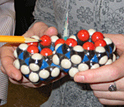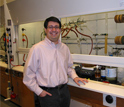|

Discovery
Chemist 'Really Jazzed' About Creating New Molecules

Lyle Isaacs talks about cool things that chemists do, such as his work to build new molecular containers that are as good as what is found in nature
July 18, 2008
Every time you spray an odor-remover like Febreze® on a stinky carpet, you unleash good-smelling chemicals that are carried in neat little protective molecules called molecular containers. Some molecular containers occur in nature. For example, in order for proteins to work correctly in the body, they have to fold into their proper three dimensional shape. To help them do that, nature uses molecular containers, known as chaperones, to provide a private space that promotes proper folding. Viruses are also molecular containers. They transport the viral genetic material, which have a big impact on human health. Taking inspiration from nature, organic chemists like me also create manmade, or synthetic, molecular containers to use in products like Febreze®. But we're also looking for ways to make molecular containers for other things that can improve people's lives. For instance, some molecular containers are able to deliver a drug exactly to the place in your body where the drug is needed, such as a cancer tumor. Other kinds of molecular containers can be made to change colors, depending on their cargo--explosives, illicit drugs and even unpleasant odors--and thereby function as "electronic noses." Nature is better But our synthetic molecular containers just aren't as good as the natural ones. For one thing, they aren't as strong or as flexible. That's why I've been trying to find ways to create even better molecular containers in my lab at the University of Maryland. But how do you make something as good--or even better--than what we find in nature? That's one of the really cool things about being a chemist! Right in my lab, I can make a molecule that has never existed. My work is kind of like building something with LEGOs®, only I try to figure out how to build a totally new molecule--or in this case, how to build a better molecular container. Of course, building new molecules isn't always easy. I've been working on finding solutions to this one problem for almost 10 years. Like most researchers, I team up with other scientists. Students in my lab work with me, and I have partners in Canada, Australia, South Korea and Japan. Breakthrough Just last year we made a breakthrough that could really be important for creating a better molecular container. We figured out how to use a molecule called a cucurbit[7]uril (or CB[7]) to make a really strong and reliable molecular container. The CB[7] acts like a strong glue, but it's still flexible. Not only does CB[7] work as well as a natural molecular container, it is also easy to prepare. We think drug companies and manufacturers will be able to synthesize, or produce it, fairly easily. That's important when you're creating something you hope will help lots of people. We were some of the first people to study CB molecules, and it was really exciting to have our experiments work. The times before you make big discoveries can be the most frustrating. When you discover something totally new, it's because you don't understand what's happening. You ask yourself: "What's going on here?" A lot of people think chemistry is all equations and numbers. But I think of it as trying to understand how the natural world works. If you like to tinker and take things apart to see how they work, you might enjoy chemistry, too. When I was a kid, I loved playing with LEGOs®, seeing how things fit together. When I started college, I was planning to become a doctor. But when I took organic chemistry for my pre-med courses, that's when I knew I didn't want to be a doctor anymore--I wanted to study chemistry. I could envision how molecules fit together chemically. I think of myself as an architect of molecules. I'm really jazzed now about the discoveries we are making. How molecular containers work In Febreze®, cyclodextrins form the molecular containers that hold different molecules that produce an aroma. When the molecular containers make contact with that smelly spot, the aroma molecules inside evaporate and release a pleasant smell. The containers continue to work, absorbing the bad smell. In drugs, many promising pharmaceutical agents cannot become marketed drugs, because they are not soluble in water. Molecular containers come to the rescue by binding the water-insoluble drug, enhancing its solubility in water, therefore allowing it to be formulated for consumer use. -- Lyle Isaacs, University of Maryland lisaacs@umd.edu This Behind the Scenes article was provided to LiveScience in partnership with the National Science Foundation.
Investigators
Lyle Isaacs
Related Institutions/Organizations
University of Maryland College Park
Locations
Maryland
Related Awards
#0615049 Cucurbit[10]uril
Total Grants
$432,390
Related Websites
LiveScience.com: Behind the Scenes: Chemist 'Really Jazzed' About Creating New Molecules: /news/longurl.cfm?id=120
Isaacs Group - University of Maryland: /news/longurl.cfm?id=121
|



![Computer image of the CB[7] Ferrocene molecular container.](https://webarchive.library.unt.edu/eot2008/20081106091803im_/http://nsf.gov/news/mmg/media/images/molec_container1_f1.jpg)
![Photo of Lyle Isaacs holding a pumpkin with the chemical structure of the CB[n] molecule.](https://webarchive.library.unt.edu/eot2008/20081106091803im_/http://nsf.gov/news/mmg/media/images/molec_container2_r.jpg)

